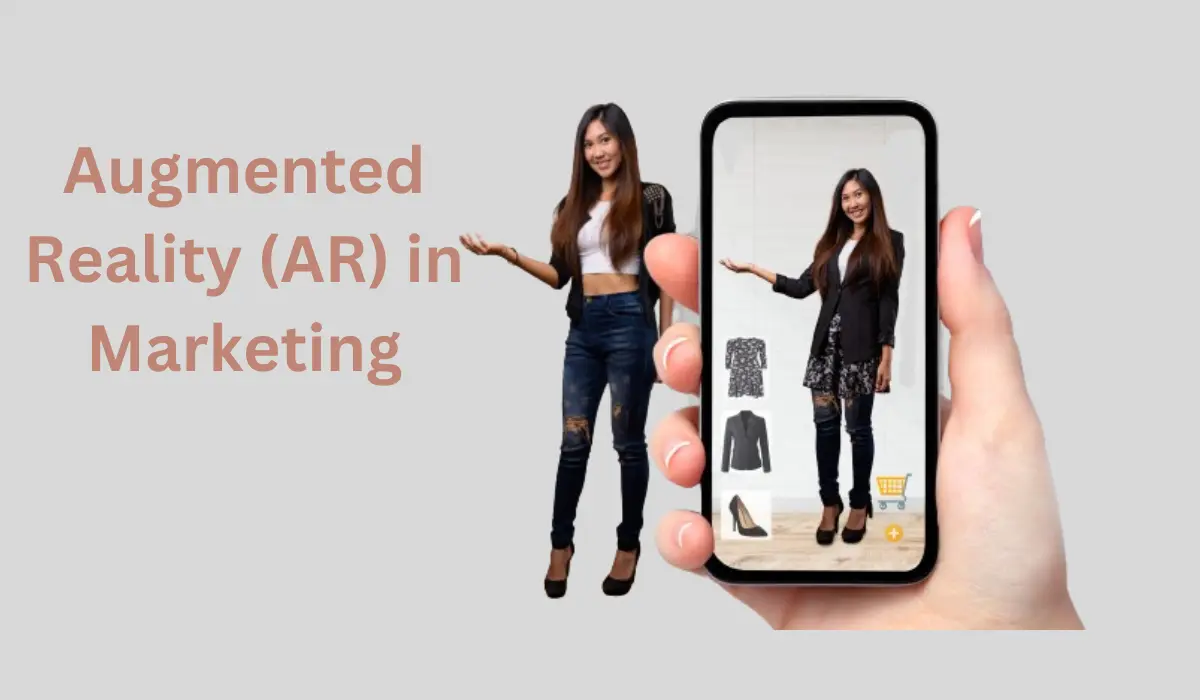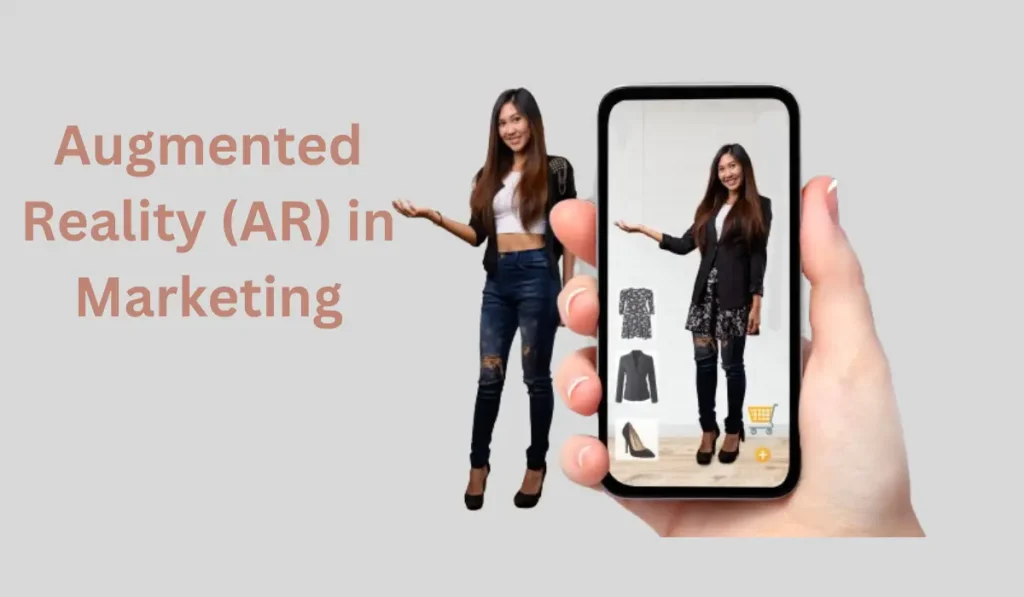In the fast-paced world of digital marketing, staying ahead of the curve is crucial for brands looking to capture and retain consumer attention. Augmented Reality (AR) has emerged as a game-changer, revolutionizing traditional marketing strategies by offering immersive and interactive experiences that blur the lines between the digital and physical worlds. From virtual try-ons to interactive product demonstrations, AR is reshaping the way brands connect with their audiences, driving engagement, and fostering brand loyalty like never before. In this context, our focus is on AR in marketing.
Let’s jump into the deep:
What is Augmented Reality (AR)?
Augmented Reality (AR) is a technology that overlays digital content – such as images, videos, and 3D models – onto the real-world environment, typically viewed through a smartphone, tablet, or AR glasses. Unlike virtual reality (VR), which immerses users in a completely digital environment, AR enhances the real world by adding digital elements, enhancing perception and interaction.
Enhancing Customer Engagement with AR
One of the key benefits of AR in marketing is its ability to captivate and engage consumers in unique and memorable ways. By integrating AR experiences into marketing campaigns, brands can create immersive storytelling opportunities that resonate with audiences on a deeper level. For example, cosmetic brands are leveraging AR to offer virtual makeup try-ons, allowing customers to visualize how different products will look on their skin before making a purchase. Similarly, furniture retailers are enabling shoppers to virtually place furniture in their homes using AR technology, providing a more realistic and personalized shopping experience.
Augmented Reality (AR) enhances customer engagement in several ways:
Interactive Experiences:
AR allows customers to interact with digital content overlaid on the real world, creating immersive and interactive experiences. Whether it’s trying on virtual clothes, placing furniture in their living room, or exploring 3D product models, AR enables customers to engage with products and brands in a more meaningful and memorable way.
Personalization:
AR experiences can be customized to suit the preferences and interests of individual customers, enhancing personalization. By tailoring AR content based on customer data and preferences, brands can create more relevant and engaging experiences that resonate with their target audience.
Visualizing Products:
AR enables customers to visualize products in their real-world environment before making a purchase decision. Whether it’s trying on virtual makeup, previewing furniture in their home, or seeing how a new car would look in their driveway, AR helps customers overcome the limitations of traditional online shopping by providing a more realistic and immersive shopping experience.
Reducing Buyer Hesitation:
AR helps to reduce buyer hesitation by providing customers with more information and confidence about their purchase decisions. By allowing customers to interact with products in a virtual environment, AR bridges the gap between online and offline shopping experiences, helping customers make more informed decisions and reducing the likelihood of buyer’s remorse.
Entertainment and Engagement:
AR experiences are inherently entertaining and engaging, capturing the attention of customers and encouraging them to spend more time interacting with brands. Whether it’s playing AR games, exploring virtual art installations, or participating in interactive marketing campaigns, AR adds an element of fun and excitement to the customer experience.
Driving Sales and Conversions
AR has proven to be a powerful tool for driving sales and conversions by reducing buyer hesitation and increasing purchase confidence. By allowing customers to interact with products in a virtual environment, AR bridges the gap between online and offline shopping experiences, mitigating concerns about product fit, appearance, and quality. Research has shown that AR-enabled product visualization can lead to higher conversion rates and lower return rates, as customers are more confident in their purchase decisions after experiencing the product virtually.
Augmented Reality (AR) drives sales and conversions by addressing common barriers to online purchasing and enhancing the overall shopping experience. Here’s how AR achieves this:
Improved Product Visualization:
AR allows customers to visualize products in their real-world environment, providing a more accurate representation of size, scale, and appearance. This enhanced visualization helps customers make more informed purchase decisions by reducing uncertainty and increasing confidence in the product.
Enhanced Engagement:
AR experiences are inherently engaging and interactive, capturing the attention of customers and encouraging them to spend more time interacting with products. This increased engagement can lead to higher conversion rates as customers become more invested in the shopping experience.
Reduced Returns:
By enabling customers to virtually try on products or see how they would look in their homes before purchasing, AR helps reduce the likelihood of returns. Customers are less likely to be disappointed with their purchase if they have had the opportunity to experience the product in a virtual environment beforehand.
Differentiation and Competitive Advantage:
Brands that leverage AR technology stand out from competitors by offering innovative and immersive shopping experiences. This differentiation can help attract new customers and retain existing ones, leading to increased sales and conversions.
Cross-Selling and Upselling Opportunities:
AR can be used to showcase related products or accessories in context, presenting cross-selling and upselling opportunities to customers. For example, a furniture retailer could use AR to show complementary decor items alongside a sofa, encouraging customers to purchase additional products.
Word-of-Mouth Marketing:
AR experiences are often memorable and shareable, leading to increased word-of-mouth marketing and social media exposure. Customers who have a positive experience with AR are more likely to share their experience with friends and family, leading to organic growth in sales and conversions.
Building Brand Loyalty and Differentiation
In today’s crowded marketplace, brands are constantly seeking ways to stand out and differentiate themselves from the competition. AR offers a unique opportunity for brands to showcase their creativity, innovation, and commitment to customer experience. By offering engaging AR experiences that delight and surprise consumers, brands can build lasting emotional connections and foster brand loyalty. Moreover, being an early adopter of AR technology can position brands as forward-thinking and tech-savvy, enhancing their reputation and appeal among tech-savvy consumers.
Augmented Reality (AR) plays a significant role in building brand loyalty and differentiation by offering unique and memorable experiences that resonate with consumers. Here’s how AR accomplishes this:
Innovative Brand Experiences:
AR allows brands to create innovative and immersive experiences that differentiate them from competitors. By offering AR-powered features such as virtual try-ons, interactive product demonstrations, or gamified experiences, brands can captivate audiences and leave a lasting impression.
Personalized Interactions:
AR experiences can be tailored to individual preferences and interests, providing personalized interactions that strengthen the bond between consumers and brands. Whether it’s customizing virtual products or delivering targeted AR content based on past behavior, personalized AR experiences make customers feel valued and understood.
Enhanced Customer Engagement:
AR experiences are inherently engaging and interactive, capturing the attention of consumers and encouraging them to actively participate in brand interactions. This heightened engagement fosters a sense of connection and loyalty as customers become more invested in the brand experience.
Emotional Connection:
AR has the power to evoke emotions and create memorable moments that resonate with consumers on a deeper level. By tapping into emotions such as excitement, curiosity, or nostalgia, AR experiences can forge strong emotional connections between consumers and brands, fostering loyalty and advocacy.
Tech-Savvy Image:
Brands that embrace AR technology project an image of innovation, forward-thinking, and tech-savviness, which can enhance their appeal to modern consumers. By positioning themselves as early adopters of AR, brands can differentiate themselves from competitors and attract tech-savvy audiences who value cutting-edge experiences.
Brand Storytelling:
AR offers a unique platform for brands to tell their story in creative and immersive ways. Whether it’s using AR to showcase the craftsmanship behind a product, bring a brand mascot to life, or transport consumers into a virtual brand world, AR enables brands to engage audiences through compelling storytelling that builds loyalty and affinity.
Exclusive Offers and Rewards:
Brands can use AR as a channel to deliver exclusive offers, rewards, or loyalty programs to incentivize repeat purchases and reward loyal customers. By integrating AR experiences with loyalty programs, brands can create a sense of exclusivity and appreciation that strengthens the bond with their most valuable customers.
Also Read
Challenges and Considerations
While the potential of AR in marketing is undeniable, implementing successful AR campaigns requires careful planning, execution, and investment. Brands must consider factors such as user experience, technical feasibility, and integration with existing marketing channels. Additionally, ensuring seamless functionality across different devices and platforms can be challenging, requiring collaboration with experienced AR developers and technology partners.
While Augmented Reality (AR) offers numerous benefits for brands, several challenges and considerations need to be addressed:
Technical Complexity:
Developing AR experiences can be technically challenging, requiring expertise in areas such as 3D modeling, computer vision, and software development. Brands need to invest in skilled developers or partner with experienced AR development agencies to ensure the successful implementation of AR campaigns.
Costs:
Building AR experiences can be costly, particularly for custom or complex projects. Brands need to budget for development costs, software licensing fees, hardware requirements, and ongoing maintenance expenses. It’s essential to weigh the potential return on investment (ROI) against the upfront costs of implementing AR.
Hardware and Platform Fragmentation:
AR experiences may not be universally accessible across all devices and platforms due to hardware and software limitations. Brands need to consider the compatibility of AR experiences with various devices, operating systems, and AR platforms to reach the widest possible audience.
User Experience:
Designing intuitive and user-friendly AR experiences is crucial for engagement and adoption. Brands must consider factors such as ease of use, navigation, onboarding, and instructional guidance to ensure a seamless user experience. Testing AR experiences with real users and iterating based on feedback is essential for optimizing usability.
Privacy and Security:
AR experiences may collect and process sensitive user data, raising concerns about privacy and security. Brands need to implement robust data protection measures and adhere to relevant privacy regulations to safeguard user privacy and mitigate the risk of data breaches or unauthorized access.
Content Creation and Maintenance:
Creating compelling AR content requires time, resources, and creative expertise. Brands need to invest in content creation tools, resources, and talent to produce high-quality AR experiences that resonate with their target audience. Additionally, maintaining and updating AR content regularly to keep it fresh and relevant is essential for long-term engagement.
Integration with Marketing Strategy:
AR should be integrated seamlessly into the broader marketing strategy to maximize its impact and effectiveness. Brands need to align AR experiences with their brand identity, messaging, and objectives to ensure consistency and coherence across all marketing channels.
Consumer Adoption and Education:
AR is still relatively new to many consumers, and there may be barriers to adoption, such as awareness, familiarity, or access to compatible devices. Brands need to educate consumers about the benefits of AR, provide clear instructions on how to access and use AR experiences and demonstrate value to encourage adoption.
The Future of AR in Marketing
As AR technology continues to evolve and become more accessible, its role in marketing is expected to expand even further. From location-based AR experiences to social AR filters and gamified marketing campaigns, the possibilities are endless. Brands that embrace AR as part of their marketing strategy stand to gain a competitive advantage in a rapidly evolving digital landscape, driving customer engagement, loyalty, and revenue in the process.
The future of Augmented Reality (AR) in marketing holds immense promise, with continued advancements in technology and evolving consumer preferences driving its widespread adoption. Here are some key trends and developments shaping the future of AR in marketing:
Integration with Social Media Platforms:
AR features, such as filters and lenses, have already gained popularity on social media platforms like Snapchat, Instagram, and Facebook. The future will see further integration of AR into social media marketing strategies, with brands leveraging AR to create immersive and shareable experiences that engage audiences and drive social engagement.
AR Wearables and Smart Glasses:
As AR technology becomes more accessible and affordable, we can expect to see a rise in AR wearables and smart glasses. These devices will enable users to experience AR content hands-free, opening up new opportunities for location-based marketing, real-time information overlays, and interactive experiences in the physical world.
AR in E-Commerce and Retail:
AR is poised to revolutionize the way consumers shop online and offline. In the future, we can expect to see widespread adoption of AR-enabled product visualization tools, virtual try-on experiences, and interactive shopping assistants that enhance the online and in-store shopping experience, driving sales and reducing returns.
AR Advertising and Brand Experiences:
Brands will increasingly leverage AR as a powerful advertising tool to deliver targeted and immersive brand experiences. AR ads will go beyond traditional formats, offering interactive and personalized experiences that capture attention and drive engagement across various digital channels.
Events and Experiential Marketing:
AR will play a significant role in events and experiential marketing, enabling brands to create memorable and interactive experiences for attendees. From AR-powered scavenger hunts to immersive product demos, AR will enhance the overall event experience, driving brand awareness and engagement.
AR for Education and Training:
AR will be increasingly used in educational and training settings to provide immersive learning experiences. From interactive textbooks to virtual simulations and hands-on training modules, AR will revolutionize the way we learn and acquire new skills, offering personalized and engaging educational content.
AR Data Analytics and Insights:
As AR usage continues to grow, brands will have access to valuable data and insights about user behavior and engagement. AR analytics tools will enable brands to track user interactions, measure campaign performance, and gain actionable insights to optimize AR experiences and drive ROI.
Augmented Reality Web and App Development:
The development of WebAR and ARKit/ARCore technologies will make it easier for brands to create and deploy AR experiences directly within web browsers and mobile apps. This democratization of AR development will lower barriers to entry and empower brands of all sizes to leverage AR in their marketing efforts.
End Words
Augmented Reality (AR) is revolutionizing the way brands engage with consumers, offering immersive and interactive experiences that drive engagement, sales, and brand loyalty. By leveraging AR technology to create memorable and personalized experiences, brands can differentiate themselves, delight customers, and stay ahead of the curve in an increasingly competitive marketplace.





